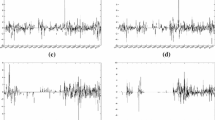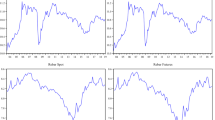Abstract
Metal mineral resources are important raw materials in industrial production, and metal as an important object in the futures market, its discovery function is an important sign to measure the level of market development. The price of metal futures market has the characteristics of high-frequency data, and the mechanism of price discovery in different frequencies needs to be realized by time series decomposition method. In this paper, the complementary ensemble empirical mode decomposition with adaptive noise vector autoregressive model is constructed to re-examine the price discovery of nonferrous metal futures from the aspects of multilevel, multi-subject, and different volumes. Four typical nonferrous metals are selected for empirical research in China. The results show that price discovery exists in China's nonferrous metal futures market. Meanwhile, there are significant differences in the functional efficiency of typical metal prices under different time scales. The volume of contracts will greatly affect the efficiency of price discovery. Finally, we also find that futures prices affect spot prices, but spot prices do not affect futures prices.





Similar content being viewed by others
Abbreviations
- CEEMDAN-VAR:
-
Complementary Ensemble Empirical Mode Decomposition with Adaptive Noise-Vector AutoRegressive
- DCC-GARCH:
-
Dynamic Conditional Correlation-Generalized AutoRegressive Conditional Heteroskedasticity
- EMD:
-
Empirical Mode Decomposition
- IMF:
-
Intrinsic Mode Function
References
Arora S, Kumar N (2013) Role of futures market in price discovery. Decision 40(3):165–179
Chen X, Tongurai J (2022) Spillovers and inter dependency across base metals: Evidence from China's futures and spot markets. Resour Policy 75:102479
Coulton JJ (2016) The impact of sentiment on price discovery. Account Financ 56:669–694
Dai X, Xiao L, Li M, Wang Q (2022) Toward energy finance market transition: Does China’s oil futures shake up global spots market? Frontiers of. Eng Manag 9
Dolatabadi S, Nielsen M, Xu K (2014) A Fractionally Cointegrated VAR Analysis of Price Discovery in Commodity Futures Markets. J Futures Markets 35(4):18
Figuerola-Ferretti I, Gilbert C (2005) Price discovery in the aluminum market. J Futures Markets 25:967–988
Figuerola-Ferretti I, Gonzalo J (2010) Modelling and measuring price discovery in commodity markets. J Econometrics 158(1):95–107
Frijns B, Indriawan I, Tourani-Rad A (2018) The interactions between price discovery, liquidity and algorithmic trading for U.S.-Canadian cross-listed shares. Int REV Financ Anal 56:136–152
Frino A, West A (2003) The impact of transaction costs on price discovery: Evidence from cross-listed stock index futures contracts. Pac-Basin Financ J 11(2):139–151
Ge Y, Cao T, Jiang R, Liu P, Xie H (2019) Does China’s iron ore futures market have price discovery function? Analysis based on VECM and State-space perspective. J Bus Econ Manag 20:1083–1101
Gong QB, Tang ZL, Xu B (2021) Trading behaviors on knowledge of price discovery in futures markets. J Innov Knowledge 6(3):191–195
Huang N, Shen S (2005) Hilbert-Huang transform and its applications. World Scientific
Kang SH, Tiwari AK, Albulescu CT, Yoon S (2019) Time-frequency co-movements between the largest nonferrous metal futures markets. Resour Policy 61:393–398
Klein T, Todorova N (2021) Night trading with futures in China: The case of Aluminum and Copper. Resour Policy 73
Li X, Zhang B (2009) Price discovery for copper futures in informationally linked markets. Appl Econ Lett 16(15):1555–1558
Liu C, Han L, Chu G (2023) The effect of overnight corporate announcements on price discovery. Financ Res Lett 53:103665
Moosa IA (2020) Futures crude oil prices as predictors of spot prices: lessons from the foreign exchange market. J Post Keynesian EC 43(3):391–416
Nair S (2021) Price discovery and pairs trading potentials: the case of metals markets. J Finan Econ Policy 13(5):565–586
Ren X, Dou Y, Dong K, Li Y (2022) Information spillover and market connectedness: multi-scale quantile-on-quantile analysis of the crude oil and carbon markets. Appl Econ 54(38):4465–4485
Rout BS, Das NM, Rao KC (2021) Competence and efficacy of commodity futures market: Dissection of price discovery, volatility, and hedging. IIMB Manag Rev 33(2):146–155
Wang Q, Dai X, Zhou D (2020) Dynamic Correlation and Risk Contagion Between “Black” Futures in China: A Multi-scale Variational Mode Decomposition Approach. Comput Econ 55(4):1117–1150
Wei Y, Bai L, Li X (2022) Normal and extreme interactions among nonferrous metal futures: A new quantile-frequency connectedness approach. Financ Res Lett 47:102855
Xu F, Wan D (2015) The impacts of institutional and individual investors on the price discovery in stock index futures market: Evidence from China. Financ Res Lett 15:221–231
Yang LB, Zhang DX (2013) Can futures price be a powerful predictor? Frequency domain analysis on Chinese commodity market. Econ Model 35:264–271
Yu H, Ding Y, Sun Q, Gao X, Jia X, Wang X, Guo S (2021) Multi-scale comovement of the dynamic correlations between copper futures and spot prices. Resour Policy 70:101913
Funding information
This research was funded by the Natural Science Foundation of China (No. 72204235, No. 71991482, No. 72074197, No. 71991480), the Major project of the National Social Science Foundation of China (No. 21&ZD106), China Postdoctoral Science Foundation(No. 2022M722948), and the Fundamental Research Funds for National Universities of China University of Geosciences (Wuhan).
Author information
Authors and Affiliations
Contributions
Yongguang Zhu: Conceptualization and formulation of the original idea, leading the drafting and implementation of the manuscript.
Ya Li: Assisted in the design and drafting manuscript.
Yuna Gong: Assisted in the implementation of the manuscript and contributed to editing and refining the overall design.
Deyi Xu: Provided supervision and oversight in the manuscript's concept, design, and implementation, with substantial contribution to the final review and editing.
Corresponding author
Ethics declarations
Competing interests
The authors have no relevant financial or non-financial interests to disclose.
Additional information
Publisher’s Note
Springer Nature remains neutral with regard to jurisdictional claims in published maps and institutional affiliations.
Appendices
Appendix A
According to the correlation coefficient between the IMFs obtained from CEEMDAN signal decomposition and the original sequence, the IMFs were reorganized into high, medium, and low frequency. The low-frequency IMF component combination can better fit the long-term trend of market changes, and the medium-frequency IMF component combination can reflect the periodic changes of the market, while the characteristics such as white noise mean regression are reflected by the high-frequency noise term. According to the combination of IMF components with similar frequency and correlation level, the original sequence can be effectively divided into three parts: 1) long-term market trend, 2) medium-term periodicity, and 3) short-term noise interference.
See Figs. 6, 7, 8, 9, 10, 11, 12 and 13.
Appendix B
The stationarity test results are shown in Appendix B. Some frequency combinations are stable, but some frequency combination time series need further processing. Through stationary tests, first-order differences, logarithm processing, and other methods, the time series of each frequency item of each metal is stable, which is convenient for subsequent related research on the VAR model.
See Table 3.
Appendix C
The price discovery function between different metals
-
(1)
Granger causality test
First, the Granger causality test is conducted to test whether one set of time series is the cause of another set of time series to analyse the two-way guiding relationship between the futures and spot of each metal.
Based on the Granger causality test results of the above four typical metals in different volume futures markets, it can be seen that gold has a strong price discovery function in both large volume futures markets and small volume futures markets. For aluminium and zinc, the strength of the price discovery function is inconsistent in futures markets with different volumes. In the large volume futures market, the price discovery function of zinc is stronger than that of aluminium, while in the small volume futures market, the price discovery function of aluminium is stronger than that of zinc. However, the price discovery function of copper is weak in both the large-volume and small-volume futures markets. As a result, the four typical metals have the strongest futures, followed by aluminium and zinc, and the weakest copper.
-
(2)
Variance decomposition
Based on the variance decomposition results of the above four typical metals in different volume futures markets, it can be seen that all metal futures have the ability to explain the variance of spot. Among them, gold futures have a strong ability to explain the variance of spots in both the large volume futures market and the small volume futures market. In addition, each metal spot has no ability to explain the variance of futures. Therefore, the interpretation ability of futures to spot variance of four typical metals varies with different trading volumes. The order of strength of large volumes is gold, zinc, aluminium and copper; the order of small volume strength is copper, gold, zinc, aluminium.
The price discovery function of different volumes of the same metal
-
(1)
Granger causality test
Based on the Granger causality test results of each frequency combination item of the above four typical metals in different volumes, the price discovery function of gold is strong regardless of whether it is a large volume futures market or a small volume futures market. The price discovery function of zinc under a large-volume futures contract is stronger than that under a small-volume futures contract. The price discovery function of aluminium and copper under small volume futures contracts is stronger than that of large volume futures contracts. Therefore, for the same metal, there is no inevitable correlation between the difference in trading volume and the strength of the price discovery function. There is no indication that the relationship that the price discovery function of a large volume futures contract is stronger or weaker than that of a small volume futures contract.
-
(2)
Variance decomposition
See Tables 12, 13, 14, and 15.
Based on the variance decomposition results of each frequency combination item of the above four typical metals in different volumes, the interpretation effects of futures on spot variance are as follows: aluminium, large volume ≈ small volume; copper, large volume < small volume; gold, large volume > small volume; and zinc, large volume ≈ small volume. Only spot zinc can explain the variance of futures to some extent under high frequency noise, while spot metal cannot explain the variance of futures.
Rights and permissions
Springer Nature or its licensor (e.g. a society or other partner) holds exclusive rights to this article under a publishing agreement with the author(s) or other rightsholder(s); author self-archiving of the accepted manuscript version of this article is solely governed by the terms of such publishing agreement and applicable law.
About this article
Cite this article
Zhu, Y., Li, Y., Gong, Y. et al. Examining the metal futures price discovery in China from multi-scale time. Miner Econ 37, 173–188 (2024). https://doi.org/10.1007/s13563-024-00430-5
Received:
Accepted:
Published:
Issue Date:
DOI: https://doi.org/10.1007/s13563-024-00430-5












